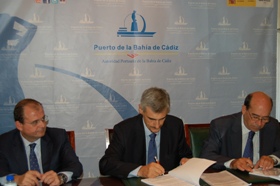The New Container Terminal at Cádiz Harbour Will Be Finished in 2015

Today the Cádiz Bay Harbour Authority signed the contract for the new terminal's construction with UTE Acciona Infraestructuras, S.A., y FCC Construcción, S.A.
The president of the Cádiz Bay Harbour Authority -Autoridad Portuaria de la Bahía de Cádiz, or APBC-, Rafael Barra Sanz, and the manager in charge of UTE Acciona Infraestructuras, S.A. y FCC Construcción, S.A., Hugo Alberto Tolosa Zemo, signed the contract for the construction of the new container terminal at Cádiz Harbour this morning. The project is a strategic step in the reorganization and fostering of harbour-related business in the bay.
As readers may remember, in late September the APBC picked the bid from the joint venture (an equal partnership between Acciona and FCC) to build the new container terminal in Cádiz Harbour at a cost of 92.04 million euro, half of which is financed with funds from the European Union's ERDF.
At the contract signing, the Harbour Authority's president declared, "This isn't just another building project. This project is something more in terms of its technical dimension, its economic dimension and, above all, what it means" for the future of Cádiz Harbour and the entire province of Cádiz.
Rafael Barra reminded those present that, in this sense, the project pursues a multiple goal: "to boost container and cruise ship traffic; to consolidate the harbour as a generator of social and economic activity; to reorganize harbour traffic and definitively split up passengers and goods; and to contribute to the bay's environmental recovery".
"With this project," the president said, "we reach the culmination of the Cádiz Bay Harbour Development Plan begun in 2000, in which we made basin specialization and traffic reorganization our key commitments".
"There's no better place and no better way of building the new Cádiz Harbour container terminal. That's not my opinion; it's a hard, scientific fact yielded by a six-and-a-half-year procedure that ensures not only the terminal's economic and financial feasibility, but also its future technical and environmental feasibility", Rafael Barra concluded.
As a sample of the terminal's profitability and the impact of the construction work alone, the joint venture's manager asserted, "During the new quay's construction, we anticipate a workload of 1,100,000 hours, with an average of 150 workers, rising to 300 at peak points".
Hugo Alberto Tolosa furthermore explained that the winning design combines a number of construction methods employing rock armour, caissons and cubic concrete blocks. It also includes the dredging of neighbouring areas as needed to enable ships to manoeuvre and to ensure the final depth of the water next to the terminal. The figures help illustrate the sheer size of the project: 3.2 million cubic metres of dredging, more than 100,000 cubic metres of concrete, a total of 8,000 cubic concrete blocks (each weighing 12 metric tons), 1.1 million cubic metres of quarry material and four million kilos of steel.
The manager of the Acciona/FCC joint venture moreover stressed that the utmost in environmental protection measures have been included in order to get the work done with the least possible environmental impact, as required by the environmental impact statement and reflected in the tender.
In this sense, he underlined that both partners will be bringing their years of expertise in designing and building large harbour structures to the project, and they have the proprietary methods and technology to have tailored their bid to the needs of the Cádiz Bay Harbour Authority.








